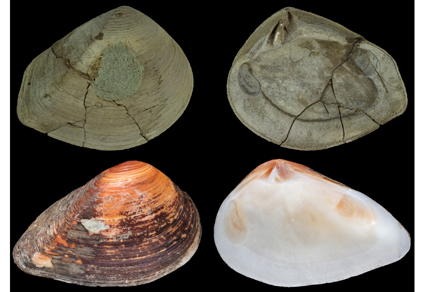Abstract
Resolving and disambiguating the many names given to fossil and Recent Crassatellidae is sometimes a knotty problem, exacerbated by the subtle differences between taxa and many applications of simple descriptive specific epithets (‘sulcata’, ‘rostrata’, ‘compressa’ etc.) leading to homonyms requiring resolution. The common decision to (perhaps) soften the blow of replacing someone’s name by erecting an eponym as a replacement to honour them has led to further unresolved homonyms and taxonomic ambiguities. One such case is addressed here.
In this paper I resolve the homonymy of Crassatella sowerbyi Wood with Crassatella sowerbyi Lamy by replacing Lamy’s name with the available junior synonym C. rubrolineata Turton. Further, I revise the suite of taxa considered by Wood to be of subspecific rank within C. sowerbyi: I synonymise C. s. var. obesa with C. sowerbyi, and elevate C. s. var. semilaevis and C. s. var. hantoniensis to full specific rank. Detailed descriptions and illustrations are provided for all species.
References
- Adams, A. (1854) Descriptions of new shells from the Cumingian collection. Proceedings of the Zoological Society of London, 1854, 90–92, pls. 15–16.
- Barnard, K.H. (1964) Contributions to the knowledge of South African marine mollusca. Part V. Lamellibranchiata. Annals of the South African Museum, 47 (3), 361–593.
- Cleevely, R.J. (1974) The Sowerbys, the Mineral Conchology, and their fossil collection. Journal of the Society for the Bibliography of Natural History, 6 (6), 418–481. https://doi.org/10.3366/jsbnh.1974.6.6.418
- Coan, E. (1984) The Recent Crassatellinae of the eastern Pacific, with some notes on Crassinella. The Veliger, 26 (3), 153–169.
- Férussac, A.E.J.P.F. d’A. de (1821–1822) Tableaux systématiques des animaux mollusques classés en familles naturelles, dans lesquels on a établi la concordance de tous les systèmes; suivis d’un Prodrome général pour tous les mollusques ou fluviatiles, vivantes ou fossiles. A. Bertrand, Paris, xlvii + 27 + 110 pp. https://doi.org/10.5962/bhl.title.10558
- Finlay, H.J. (1927) New specific names for Austral Mollusca. Transactions of the New Zealand Institute, 57, 488–533.
- Gmelin, J.F. (1791) Vermes. In: Gmelin, J.F. (Ed.), Caroli a Linnaei Systema Naturae per Regna Tria Naturae. Tome 1. Pars. 6. 13th Edition. G.E. Beer, Lipsiae [Leipzig], pp. 3021–3910.
- Habe, T. (1951–1953) Genera of Japanese shells. Pelecypoda and Scaphopoda. Part 1. s.n., Kyoto, 96 pp.
- Huber, M. (2010) Compendium of bivalves. ConchBooks, Hackenheim, 907 pp.
- Iredale, T. (1924) Results from Roy Bell’s molluscan collections. Proceedings Linnean Society New South Wales, 49, 179–278.
- Kobelt, W. (1885) Zwei neue Crassatellen. Nachrichtsblatt der deutschen malakozoologischen Gesellschaft, 17 (11/12), 185–186.
- Lamarck, J.B.M. (1799) Prodrome d‘une nouvelle classification des coquilles, comprenant une rédaction appropriée des caractères géneriques, et l‘établissement d‘un grand nombre de genres nouveaux. Mémoires de la Société d’Histoire Naturelle de Paris, 1, 63–91.
- Lamarck, J.B.M. (1805) Suite des mémoires sur les fossiles des environs de Paris. Annales du Muséum d’Histoire Naturelle, 6, 117–126 + 214–226 + 335–345 + 407–415, pls. 43–46.
- Lamy, É. (1917) Révision des Crassatellidae vivants du Muséum d’Histoire Naturelle de Paris. Journal de Conchyliologie, 62 (16), 197–270.
- Newton, R.B. (1891) Systematic list of the F. E. Edwards collection of British Oligocene and Eocene mollusca in the British Museum (Natural History), with references to the type-specimens from similar horizons contained in other collections belonging to the Geological Department of the Museum. British Museum, London, xxviii + 365 pp.
- Petit, R. (2009) George Brettingham Sowerby, I, II & III: their conchological publications and Molluscan taxa. Zootaxa, 2189 (1), 1–218. https://doi.org/10.11646/zootaxa.2189.1.1
- Sowerby, J. de C. (1850) Description of, and remarks on the Tertiary shells from Bracklesham and Selsey. In: Dixon, F., The geology and fossils of the Tertiary and Cretaceous formations of Sussex, Longman, Brown, Green and Longmann, London, pp. 162–194 + 222–228, pls. 2–9, 14–15.
- Sowerby, G.B. III (1889) Further notes on marine shells of South Africa, with descriptions of new species. Journal of Conchology, 6, 147–159.
- Sowerby, G.B. III. (1892) Marine shells of South Africa. A catalogue of all the known species with references to figures in various works, descriptions of new species, and figures of such as are new, little known, or hitherto unfigured. G. B. Sowerby, London, 89 pp., 5 pls. https://doi.org/10.5962/bhl.title.15194
- Tomlin, J.R. le B. (1931) On South African marine Mollusca, with descriptions of new genera and species. Annals of the Natal Museum, 6 (3), 415–450, pl. 33.
- Tracey, S., Todd, J.A., Le Renard, J., King, C. & Goodchild, M. (1996) Distribution of Mollusca in Units S1 to S9 of the Selsey Formation (middle Lutetian), Selsey Peninsula, West Sussex. Tertiary Research, 16, 97–140.
- Turton, W.H. (1932) The marine shells of Port Alfred S. Africa. Humphrey Milford, London, xvi + 331 pp., 70 pls.
- Wood, S.V. (1871) A Monograph of the Eocene Mollusca, or, Descriptions of Shells from the Older Tertiaries of England. Part I. Bivalves. Monographs of the Palaeontographical Society, 13 (58), 1–74. https://doi.org/10.1080/02693445.1861.12027931


